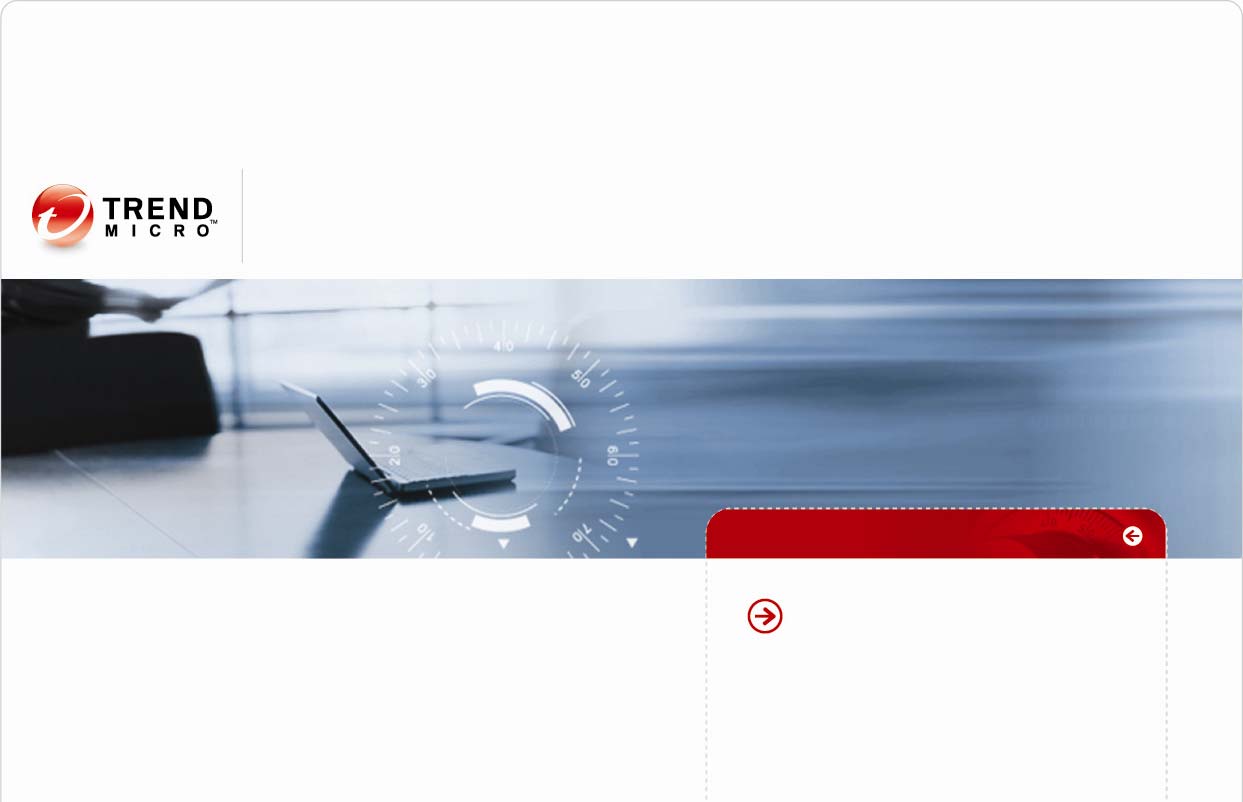Microsoft word - wp03_spam_100824us

The Spam Scramble
A Trend Micro White Paper
Ever-Growing Spam Volumes Demand a New Approach to Email Security
August 2010
Learn about new antispam best
practices and the hybrid solution
with the power of two

THE SPAM SCRAMBLE
EVER-GROWING SPAM VOLUMES DEMAND A NEW APPROACH TO EMAIL SECURITY
I. INTRODUCTION
Spam continues to plague enterprises. Rising volumes and more targeted phishing attacks threaten
enterprise security, especially those with antiquated antispam and anti-malware solutions. The changing
nature of spam and Internet borne malware coupled with the increasing volumes have created an urgent
need for a new set of best practices and next-generation security solutions that go beyond the scope of
traditional email security.
The rise in spam volume is not only costly in network resources such as bandwidth, CPU processing, and IT
help desk time, the drain on end user productivity in organizations is staggering. In fact, Ferris Research
estimated that in 2009, spam cost enterprises $110 billion in reduced productivity worldwide.
In addition to the growing volume and nuisance of unwanted mail, spam has become more dangerous.
Enterprises are becoming targets of spear phishing and other targeted attacks. Plus the majority of spam
email now contains links to malicious websites where malware is waiting to infect unsuspecting users. And
since email with bad links doesn't necessarily contain the malicious code itself, these threats can slip past
conventional signature-based email security.
According to TrendLabs, in 2010, 90-97% all email traffic directed towards enterprises is ‘spam'. In addition,
Trend Micro has seen the volume of spam more than double in the past year—with about 200 billion spam
emails sent per day.
SPAMMERS—WHO ARE THEY AND WHY DO THEY PERSIST?
The senders of the spam are often part of a criminal gang that uses email to
A sample of spam industry "goods for
lure victims and ultimately steal enterprise or customer data—credit cards,
sale" by Russian Underground
bank account numbers, or confidential information they can either use
(source: TrendLabs, 2010)
themselves or sell on the black market for illegal profit. These gangs treat
Post 1: 1 million custom emails of your
cybercrime as a serious and lucrative business venture and work diligently to
choice for $100
expand their criminal networks—with little risk of capture.
Post 2: $20 per day to rent spam
Organizations such as the Russian Mafia, the Chinese Triads and other
criminal organizations have quickly adapted to the "digital underground,"
Post 3: 1000 valid emails for $7. Has
where it's very difficult to trace the true sources of spam messages.
$50K validated Yahoo emails
Messages can be sent from nearly anywhere in the world with no physical
available.
presence required.
Post 4: $50 per day, 100 emails per
In addition, spam is actually not illegal in all countries. In some regions,
Post 5: Bundle of 100 bots, total of
spam is viewed as a legal form of advertisement. This presents a significant
1012 mails/min. Max of 8k bots for
problem for law enforcement agencies—since emails cross multiple borders,
hire. $650 dollars to rent for a week,
each with different enforcement agencies and incongruent policies on
customer can try for free.
cybercrime, making prosecution nearly impossible.
Often these criminal organizations use stolen credit card credentials to pay
for web hosting. For example, they will pay for a month of web hosting with
1 White Paper The Spam Scramble

THE SPAM SCRAMBLE
EVER-GROWING SPAM VOLUMES DEMAND A NEW APPROACH TO EMAIL SECURITY
stolen credit card numbers or take out a free trial, using stolen credit card numbers as deposit. These
websites are used as fraudulent storefronts, and of course victims are lured to these sites by deceptive
Industry estimates on the global revenue from organized cybercrime vary, with criminal organizations
earning millions of dollars annually. Legitimate enterprises that become victims of cybercrime pay the
highest price. Ponemon Institute, "… found that the median annualized cost of cybercrime of the 45
organizations in our study is $3.8 million per year, but can range from $1 million to $52 million per year per
SPAMMING TECHNIQUES
Spammers today utilize a myriad of methods to propagate their spam messages in an effort to generate
Botnets: networks of "zombie" malware-infected PCs send email on
Mega-D is the name of one of the most
behalf of the spammer, without the knowledge of their legitimate owners.
widespread spam botnets today, though
Botnets are controlled by a botmaster, who sells a spamming service to those who wish to send spam.
not as prolific as it once was. A single
Mega-D spam bot was able to generate
Free email services: public Webmail (for example, Yahoo! Mail) is
misused to send spam.
around 2,553,940 spam messages in a
span of 24 hours, an average of 1,764
Open proxies: compromised or misconfigured servers can be used to
redirect spam. Known in spammer slang as "peas," open proxies are
spam messages per minute.
also sold as a service to spammers in a similar way as botnets.
Stolen netblocks: Spammers set up in business as an ISP, typically by
taking over portions of Internet address space
MORE ABOUT THE BOTNET THREAT
Spammers are increasingly using "bots", or host computers, which have been compromised through
malware to send spam without the knowledge of their owners.
Often these spam bots will be part of a larger "botnet," which may consist of many millions of compromised
machines controlled by a "bot herder".
Trend Labs has noticed large outbreaks of spam originating out of botnets within legitimate MTAs of major
Internet Service Providers. A compromised machine within an Internet Service Provider (ISP) can send
spam directly or the bot can initiate a session with the ISP's legitimate mail server. Trend Micro continues
to work with ISP's to trace and clean the offending IP addresses from their networks.
2 White Paper The Spam Scramble

THE SPAM SCRAMBLE
EVER-GROWING SPAM VOLUMES DEMAND A NEW APPROACH TO EMAIL SECURITY
Figure 1 shows the size of a particular botnet between March 2010 and the end of July 2010.
As shown, the botnet's size has fluctuated over time; it currently comprises around 150,000 bots.
This is not a huge botnet but it still generates multimillion dollars in annual revenue.
Often the services of the botnet are rented out to third parties for illegal activities such as performing a
Denial of Service (DDOS) attack, where the target system is flooded with data in order to slow it down or
stop it from responding entirely. DDOS services are for sale for about $70 per day, a small price to cripple a
INCREASED SPAM = RISING COST OF SECURITY
The increased volume of bot-generated spam has required enterprises to
Best practice tip:
provide additional resources to process mail, additional bandwidth to receive
Set antispam and antivirus filtering
the emails, additional storage at their final destination, and investigate new
policies for outbound email in addition to
strategies for removing the bad mail from their valid business mail.
inbound email. This way, a spam
generating computer will be quickly
While antispam technologies are continually improved to tackle the problem,
identified within your corporate network.
the spammers understand that they too need to evolve their spam. Most
commercial spam filters are updated frequently to allow them to detect the
latest spam methods, and therefore do a good job detecting spam on a daily
basis. In general, an up-to-date antispam engine will typically catch most
spam, but its effectiveness will drop in a matter of hours or days if not
3 White Paper The Spam Scramble

THE SPAM SCRAMBLE
EVER-GROWING SPAM VOLUMES DEMAND A NEW APPROACH TO EMAIL SECURITY
While email administrators strive to preserve the usefulness of their email systems by reducing spam, at the
same time, they also need to ensure that legitimate email continues to flow and does not get blocked
mistakenly as spam. These "false positives" are possibly more critical to the continuity of a business than
allowing a small amount of spam to pass through. More importantly, antispam vendors need to keep refining
their detection techniques to take into account the latest spam threats. At the same time, security vendors
need to continually work to minimize false detections to ensure that the spam/not spam balance remains
acceptable to the user.
SPAM CONTROL - SECURITY FEATURES AND BEST PRACTICES
Now that we've discussed the challenges of today's threat landscape, let's take a closer look at the
technologies used by modern antispam solutions.
EMAIL AND WEB REPUTATION SERVICES
Central to the fight against the high volume of spam are reputation services.
Best practice tip:
Email reputation service analyzes the history of an email server in order to
Enterprises should use a high-quality
assign a reputation rating. Typically email reputation is available as a
email reputation service as a first line of
centralized cloud service, queried on demand, allowing an email
defense. This will reduce the number of
administrator to create policies to block or delay the messages based on the
email servers required to further process
reputation rating of the sender—usually a known or suspected spammer.
the remaining email traffic.
Email reputation services can save a considerable amount of resources by
rejecting up to 85 percent of all incoming email.
Best practice tip:
In addition, advanced antispam engines will employ web reputation by
Web reputation is a very powerful tool
extracting embedded URL's in emails and comparing them to an in-the-cloud
within an antispam engine, providing
list of known websites that have a poor reputation, as they are known to
excellent defenses against both phishing
harbor malware or be used by known spammers. This approach is especially
emails and links to malware -infected
effective against phishing mails where the URL in the message will take the
sites. When choosing an antispam
user to an infected site, in some cases, a clone of a valid site, with the intent
technology this should be one of the key
to steal the victim's login or financial details.
criteria.
VALID RECIPIENT CHECKING, RATE LIMITING,
AND DIRECTORY HARVESTING
The list of email addresses that spammers use to peddle their wares are typically compilations of addresses
bought and sold on the underground market. These lists are compiled from many sources—taken from
compromised systems, such as poorly protected (or unethical) ecommerce stores and web servers requiring
registration, or directly from the address books of end users that have been infected with a bot.
4 White Paper The Spam Scramble

THE SPAM SCRAMBLE
EVER-GROWING SPAM VOLUMES DEMAND A NEW APPROACH TO EMAIL SECURITY
Another method of obtaining recipient email address lists is done through
Best practice tip:
brute force. Leveraging the immense processing power of the botnets within
Many email content security solutions
their command, the spammers will simply guess at common email
have options to automatically update the
addresses, using large dictionaries of common forenames, surnames and
list of valid recipients, by integrating with
address syntaxes, e.g.:
corporate LDAP. Enabling this
functionality means that the list of valid
[email protected]
recipients will be automatically updated in
[email protected]
a timely fashion without additional steps
[email protected]
for the administrator.
[email protected]
Best practice tip:
Once an organization is under attack, the corporate email server will reject
If your email security solution has options
messages for unknown recipients. Each of these rejections is logged as an
to enable directory harvest protection and
invalid email address and the next combination is attempted. This technique
rate limiting, you should enable these.
is known as a directory harvest attack, as the spammer will attempt to guess
However, you should monitor the email
every email address within the corporate address book. Once harvested, the
flows carefully as in some cases this may
directory information will be used to build new spam lists, or if the company
cause valid emails to be delayed. Your
is well known, resold on the black market to allow targeted attacks to be
security vendor should be able to provide
carried out against that organization.
details on how to test and configure
these features if necessary
The main defense against this kind of attack is a combination of a valid
recipient list, combined with intelligence about the connections into email
security software. Great care needs to be taken to ensure that by rejecting messages to unknown recipients,
you don't expose the valid addresses during a directory harvest attack. This is done either by accepting and
silently dropping messages to invalid recipients or by monitoring the mail flow into each domain, and then
applying intelligent rate limiting.
HEURISTIC ANTI SPAM ANALYSIS
Another weapon in the battle against spam is the heuristic-based antispam
Best practice tip:
engine. During heuristic analysis, the spam message is processed by a
The heuristic antispam engine should be
series of many hundreds or thousands of rules, dependant on the complexity
set at the default level, and set to tag
of the antispam engine in use. These rules look for the occurrences of key
spam messages rather than delete them.
words, patterns, and characteristics within the message that would be
The sensitivity can gradually be raised
indicative of spam. Such rules may look for key words often used in spam,
over a period of time to balance the catch
such as Viagra, the proximity of words in relation to other words, such as
rate versus the false positive rate. More
looking for "discount" close to "medication," attempts to obfuscate or hide
advanced solutions offer the option to
words—instead of using "Viagra," character replacement would be used to
take different actions based on the
create a word that looks similar to the human eye, such as "v1ágrá." Other
probability of spam. For example, the
common rules search for items such as whitespace or lightly colored text in
email administrator could create a rule to
between characters such as "vabicdaefghirjka". Another key rule is the
delete messages that are highly likely to
analysis of any URLs located within the message.
be spam, and quarantine or tag
messages that are less certain.
5 White Paper The Spam Scramble

THE SPAM SCRAMBLE
EVER-GROWING SPAM VOLUMES DEMAND A NEW APPROACH TO EMAIL SECURITY
For each of these rules executed against the message, a score is given, with
Best practice tip:
a total score provided after processing all of the rules. If the total score for
For any antispam solution to be effective,
the message exceeds the thresholds set, then the message is considered
it should be granular enough to allow
spam and treated accordingly. The setting of the thresholds for heuristic
different policies and sensitivities to be
antispam engines is one of the most problematic areas of email security—if
applied to different domains or groups of
the heuristic engine is too "aggressive," then the spam catch rate will be very
domains as they are likely to have
high, but so will the false positive rate. If it's too low, then there will be
differing requirements.
minimal false positives, but a high volume of undetected spam. A ‘one size
fits all' approach to spam sensitivity rarely fits all customers due to the wildly
different types of legitimate email traffic—nearly all heuristic engines require
Best practice tip:
a degree of tuning to their environment to be most effective.
A gateway email security solution should
leverage machine learning for phishing
ADAPTIVE TECHNOLOGIES
and spam outbreak prevention.
Another layer of protection essential to today's threat landscape is
Gateway email security should be part of
responsive and adaptive technologies, both locally and through community
a larger threat intelligence community, so
that there is global threat intelligence
Statistical analysis, machine learning, and adaptive technologies can be
used at an organization's gateway by tracking traffic patterns, hashing email
messages, pulling out information in embedded URL links, looking for content typical of spam and other
behaviors which would indicate a spam attack. These patterns and signatures can be used to stop a
targeted spam or phishing attack in its tracks—right at the targeted enterprise gateway. The pattern files
can then be shared with all enterprises through a cloud-based repository of information. And with a global
system of correlated threat data, all customers are better protected from spam outbreaks compared to an
email security appliance sitting alone at the network edge. In particular, enterprises benefit from much
needed zero day protection against emerging threats.
CLOUD SERVICE FOR ANTISPAM
To counter the need for dedicated on-premise hardware and support, many
Best practice tip:
customers are looking to cloud-based antispam solutions to avoid these
Using a cloud service to block a high
resource costs, routing their email messages through a third party for
proportion of emails before they reach
scanning before they are delivered into their infrastructure. Cloud-based
the customer's network, drastically
services are designed to be on-demand and elastic in order to provide
reduces resource utilization in both the
flexibility in both, cost and scalability, as well as having a centralized team of
customer's email servers and internet
mail security experts to ensure that the solution employs the latest antispam
connection. This service should be
techniques to maximize detection rates. Enterprises can, and should,
backed by an aggressive Service Level
leverage the cloud to provide a first line of defense for spam filtering.
Agreement (SLA).
6 White Paper The Spam Scramble

THE SPAM SCRAMBLE
EVER-GROWING SPAM VOLUMES DEMAND A NEW APPROACH TO EMAIL SECURITY
THE INDUSTRY'S FIRST HYBRID EMAIL SECURITY:
INTERSCAN MESSAGING SECURITY VIRTUAL APPLIANCE
Trend Micro has developed the industry's first integrated hybrid SaaS email security solution designed to
provide the benefits of both a cloud-based solution (to remove a high percentage of messages within the
cloud), and an on-premise VMware Ready virtual appliance (to give an enterprise the fine level of policy
enforcement that they require and the privacy they prefer). With this hybrid solution, enterprises can
minimize outlay on expensive dedicated appliances and also leverage the latest virtualization technologies.
LAYERED SECURITY MANAGED FROM A SINGLE CONSOLE
These components are linked transparently, one in the cloud to remove a large percentage of unwanted
inbound emails, and another on the enterprise premises, for more granular policies and policy/privacy
enforcement of outbound email. This greatly simplifies the configuration process for the enterprise since
both cloud and on-premises components are managed from a single console. In addition, the solution
queries its local message tracking logs, and searches the cloud component of the solution for the equivalent
logs. A single set of results are shown, combining both local and cloud results into a single log.
FIRST LINE OF DEFENSE: EMAIL REPUTATION AND WEB REPUTATION
InterScan Messaging Security Virtual Appliance employs email reputation, web reputation, traffic shaping,
and heuristics—to weed out unwanted content before it hits the network edge. These technologies leverage
unique cloud-client architecture, powered by the Trend Micro™ Smart Protection Network™, a global
network of threat intelligence sensors. Email reputation policies stop mail sent by known spammers—
blocking up to 85 percent of all email. Meanwhile, web reputation blocks emails with links to infected or
malicious websites. Email, web, and file reputation threat data is correlated by the Smart Protection Network
in the cloud to stop threats as soon as they emerge. As the volume of threats increases to thousands per
hour, the need for comprehensive, immediate and correlated threat intelligence is critical to protecting your
PRIVACY AND CONTROL WITH ON-PREMISE SECURITY
Emails flagged for further inspection are quarantined on premise; no email is stored in the cloud—none.
Inbound email security layers including DHA protection, machine learning, and granular content filtering
controls are also available on premise. In addition, outbound content inspection, spam and virus filtering,
and encryption secure outbound content and provide early detection of bot activity.
THE HYBRID SOLUTION ALIGNED WITH ALL OF TODAY'S ANTISPAM BEST PRACTICES
The hybrid email security approach within InterScan Messaging Security Virtual Appliance removes many of
the obstacles for enterprises that desire the benefits of both an in-the-cloud solution and an on-premise
solution. And the benefits are significant, including lower management overhead and better alignment with
antispam best practices as discussed within this document. The results set a new standard in terms of
greatly reducing the volumes of spam received by the enterprise—without interfering with business critical
2010 Trend Micro, Incorporated. All rights reserved. Trend Micro, InterScan, Trend Micro Smart Protection Network, and the t-ball logo are trademarks or registered trademarks of Trend Micro, Incorporated. All other product or company names may be trademarks or registered trademarks of their owners. Information contained in this document is subject to change without notice. WP03_Spam_100824US
7 White Paper The Spam Scramble
Source: http://www.trendmicro.dk/media/wp/spam-whitepaper-en.pdf
October 2015 EurEau's Contribution to the European Commission's Strategic Approach on Veterinary Pharmaceuticals in the Environment Globally, pharmaceutical products are regularly administered to both livestock and domestic animals. This is essential for animal welfare and the economy, but doing so ultimately means that pharmaceuticals end up in the aquatic environment. Animals reared commercially are the highest consumers of these products and therefore veterinary medicines are largely a rural, rather than an urban, issue. EurEau believes that good agricultural and animal husbandry practices should be promoted and incentivised. Doing so will reduce the overall amount of pharmaceuticals in the environment and protect water resources, including those used for the abstraction of drinking water. As the main route for veterinary pharmaceuticals to the aquatic environment is diffuse, addressing their use at the source is the most effective solution.
20th Biennial International SAAFoST Congress and Exhibition– Final Programme 7 - 10 October 2013, CSIR International Convention Centre, Pretoria Monday, 7 October 2013 07h00-08h30 Registration in Central Foyer / Tea and Coffee in Exhibition Hall Plenary session Venue: Diamond Auditorium








